The possibilities are endless with this creamy polenta recipe! Make it sweet with berries and a drizzle of honey, or savory with mushroom ragout and sausage.
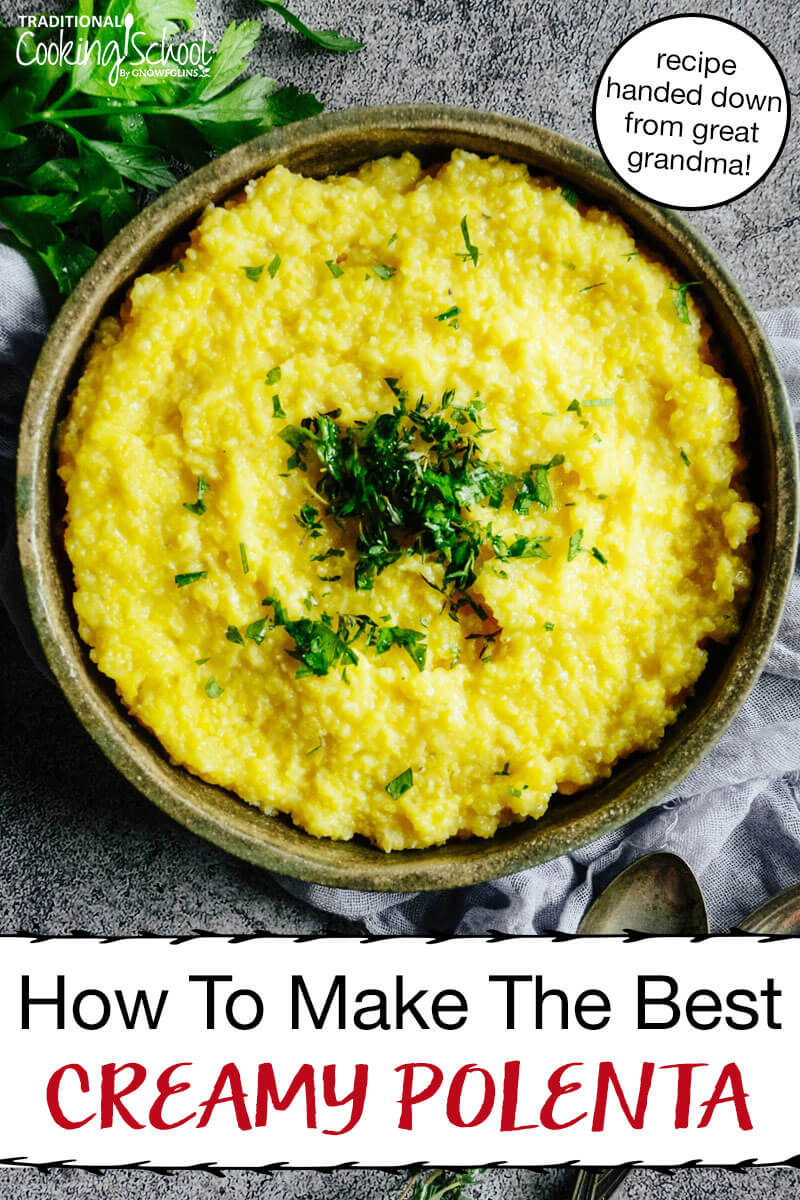
When I hear “creamy polenta”, I inevitably think of comfort food.
Polenta was an essential food growing up and still is a staple in Romanian cooking.
Despite polenta being a rather simple dish, it feels special every time I make it. I don’t know if it’s the golden color or texture that works so well in so many dishes, but polenta holds a special place in my heart.
My fondest memory of making creamy polenta takes me back to my great-grandmother’s kitchen in a tiny village. It was located just a few hours outside the city I grew up in, where my cousins and I spent nearly every summer as children.
There, in a modest kitchen without running water or electricity, my great-grandmother hovered over the wood stove, quietly stirring. She wore black on most days and kept her long white hair, tightly wrapped in a bun, hidden beneath a black headscarf.
Her hands, though calloused and arthritic from years of labor, worked swiftly to prevent the polenta from sticking. From time to time, I’d get a turn at stirring, happily watching the buoyant bubbles as they made their way to the surface.
The end result was always a perfectly creamy polenta that my cousins and I couldn’t wait to dig into.
Polenta is by far one of the easiest dishes to make. It requires very few ingredients and is also quite versatile, easily working in savory as well as sweet dishes.
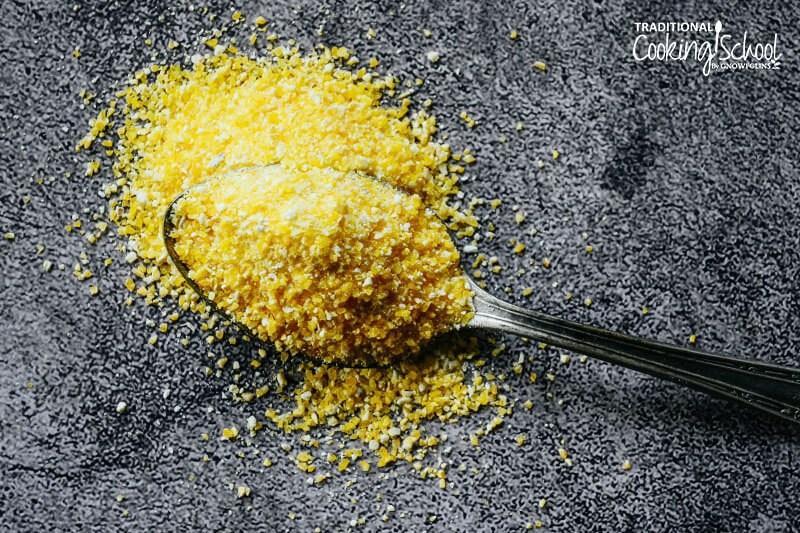
What Is Polenta?
Polenta in its simplest form is ground up yellow corn prepared with chicken broth and/or water, butter or ghee, and salt.
I’ve noticed that cornmeal and polenta are used interchangeably at times. However, cornmeal is usually ground more finely and will not yield the same consistency as actual polenta.
When shopping, look for cornmeal that’s clearly labeled polenta so you can achieve the beautiful golden creamy texture of creamy polenta.
How To Source The Best Polenta
Sadly, we live in a time where corn isn’t what it used to be. I know if you’re reading this post, you likely care about the quality of the food you and your family eat.
When purchasing your polenta, look for trusted brands from reliable sources. Always choose organic and non-GMO.
Most grocery stores sell polenta in the organic aisle, or online is a good option, too.
How To Soak Polenta
In Romania and in traditional cooking, most grains are soaked prior to cooking.
Unlike other grains, however, corn requires an extra soaking step involving lime water to release bound-up Vitamin B3 (niacin). This step, called nixtamalization, is very easy to do, and requires no more effort than regular soaking, although you do have to think ahead.
Nixtamalization dates back to the Native American peoples who prepared their corn by soaking it in lime water. Although their diet was high in corn, by preparing it this way, they protected themselves from a disease called pellagra which was later determined to be caused by a niacin deficiency.
Even if you don’t want to nixtamalize your corn, I do encourage you to soak your polenta overnight regardless. This will cut down on cooking time and make it much easier on digestion.
While grains are generally soaked and drained, then rinsed and cooked in fresh water, the polenta grains are far too small to soak and drain so I cook them in the same water.
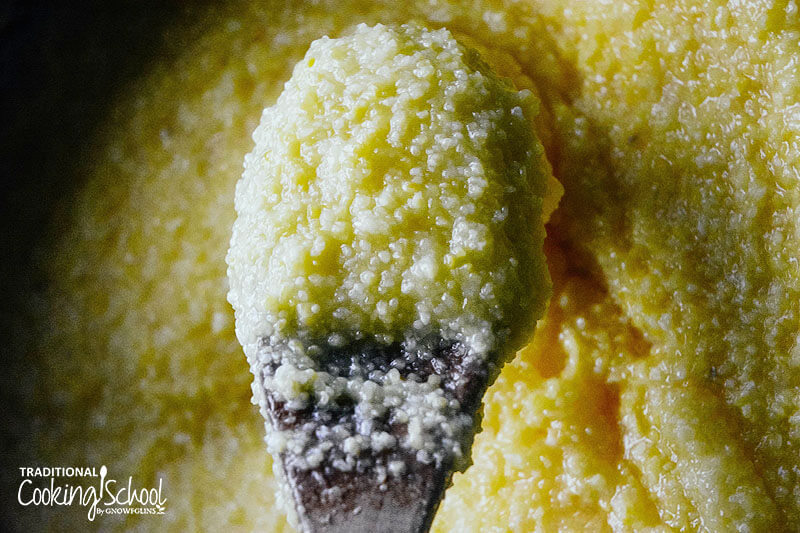
How To Cook Creamy Polenta
When cooking polenta, everything comes down to the process. You have to keep an eye on it, or it can end up lumpy, too watery, or too hard.
The most important step is continuous stirring. Whisk constantly.
I recommend staying close to the stove until the polenta reaches a thick, semi-sticky consistency.
Then to get the silky smooth texture, stir in butter. I actually prefer to use ghee because it is nuttier tasting and also wonderful for gut health.
Ghee can be found in any store these days or you can make your own!
Creamy polenta will inevitably harden the longer it sits (at room temperature or in the refrigerator)…
Simply heat it the next day with a little broth or water, stirring continuously, to revive the polenta and bring it back to life. Another dollop of ghee or butter won’t hurt either!
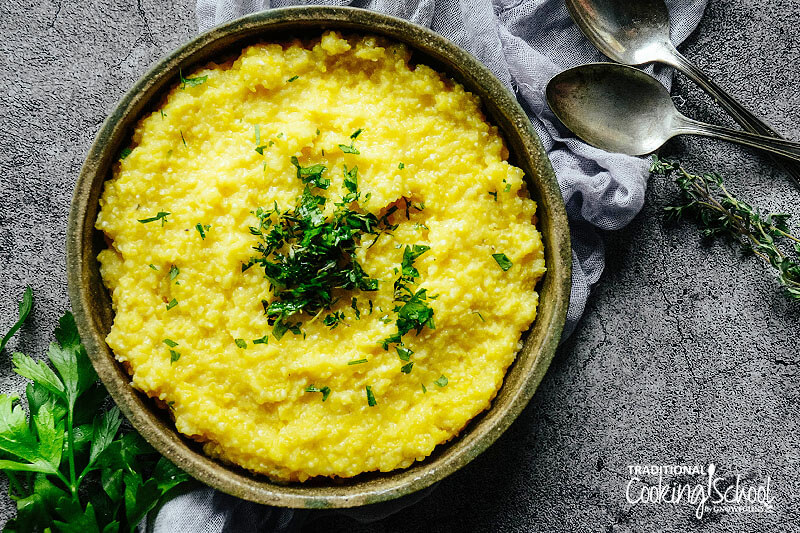
What To Serve With Creamy Polenta
Polenta, similar to French crepes, are neutral at their core. If you want a sweet dish, you can easily top it with berries and nuts, honey and jams… or if you go savory (my favorite way), the possibilities are endless.
I personally love pairing my creamy polenta with a mushroom ragout and sausage. Or, enjoy it as a side dish with chicken or seafood, steak, a simple sauce, or roasted veggies and herbs.
You could also let your polenta come to room temperature and press it flat, creating a thin layer. Cut this layer into triangles and fry as a base for an appetizer. Top it with pesto, replace your traditional bruschetta, or get as creative as you want!
I’d love to hear how you like to eat polenta and whether you like it in sweet or savory dishes!
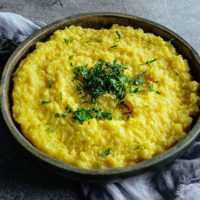
Best Creamy Polenta Recipe
The possibilities are endless with this creamy polenta recipe! Make it sweet with berries and a drizzle of honey, or savory with mushroom ragout and sausage.
Ingredients
- 2 cups polenta cornmeal uncooked
- 1 cup lime water see Notes on how to make lime water from pickling lime, below
- 1/4 cup raw apple cider vinegar or other acidic medium, such as kefir, yogurt, Kombucha, water kefir, whey, etc.
- 5 cups pure water
- 1 cup chicken broth or broth of choice
- 3 tablespoon grass-fed ghee or grass-fed butter
- 1 1/2 teaspoons sea salt
Instructions
The morning before the day you want to cook...
-
Carefully combine polenta and lime water in a large saucepan or pot. Lime water can irritate the skin, so be careful not to touch it. If you do, quickly wash it off with water.
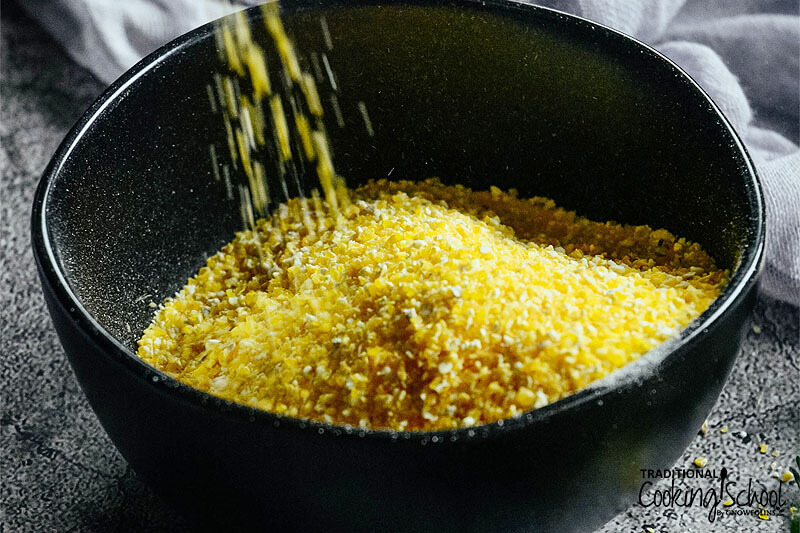
-
Cover and let sit at room temperature for 7 hours.
The afternoon before the day you want to cook...
-
Add raw apple cider vinegar or other acidic medium to polenta and lime water mixture.
-
Cover and let sit at room temperature for 12 to 24 hours.
Anytime on the day you want to cook...
-
When ready to cook the polenta, add water and salt to the pot. Do not drain away the lime water.
-
Whisk constantly while bringing mixture to a simmer.
-
When the polenta starts to thicken a little, add 1 cup broth.
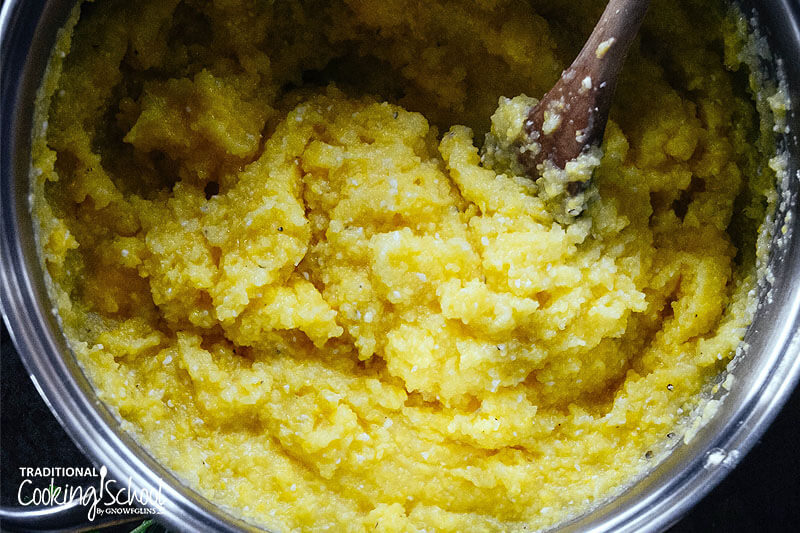
-
Continue cooking on low heat, still stirring, until mixture resembles a thick, semi-sticky consistency.
-
Add ghee and stir until well incorporated. The texture should become silky smooth.
-
Add additional salt, if desired.
-
Let polenta cool slightly and serve with toppings of choice!
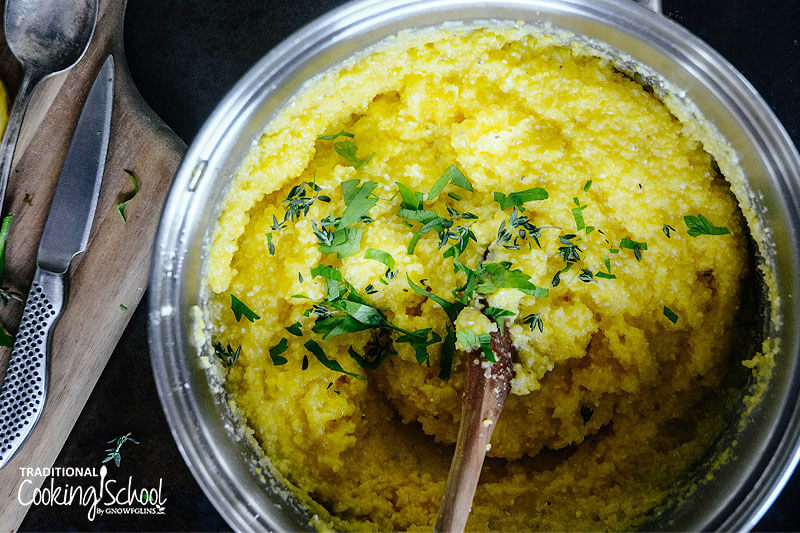
Recipe Notes
The book Nourishing Traditions by Sally Fallon explains how to make lime water:
To make lime water, place about 1 inch pickling lime in a 2-quart jar. Fill jar with filtered water, shake well, cover tightly, and let stand overnight. The powder will settle and the resultant clear liquid is lime water. Store in a cool place (it’s not necessary to refrigerate) and use for soaking cornmeal by pouring out carefully.
If you don't have pickling lime or don't want to nixtamalize your corn, simply combine 6 cups water, 2 cups polenta, and 1/4 cup raw apple cider vinegar in a large saucepan or pot. Cover and let sit at room temperature overnight. The next day, add the salt. Whisk constantly while bringing mixture to a simmer. When it starts to thicken a little, add 1 cup broth. Then proceed with the recipe as written.
Do you prefer savory polenta or sweet?
We only recommend products and services we wholeheartedly endorse. This post may contain special links through which we earn a small commission if you make a purchase (though your price is the same).


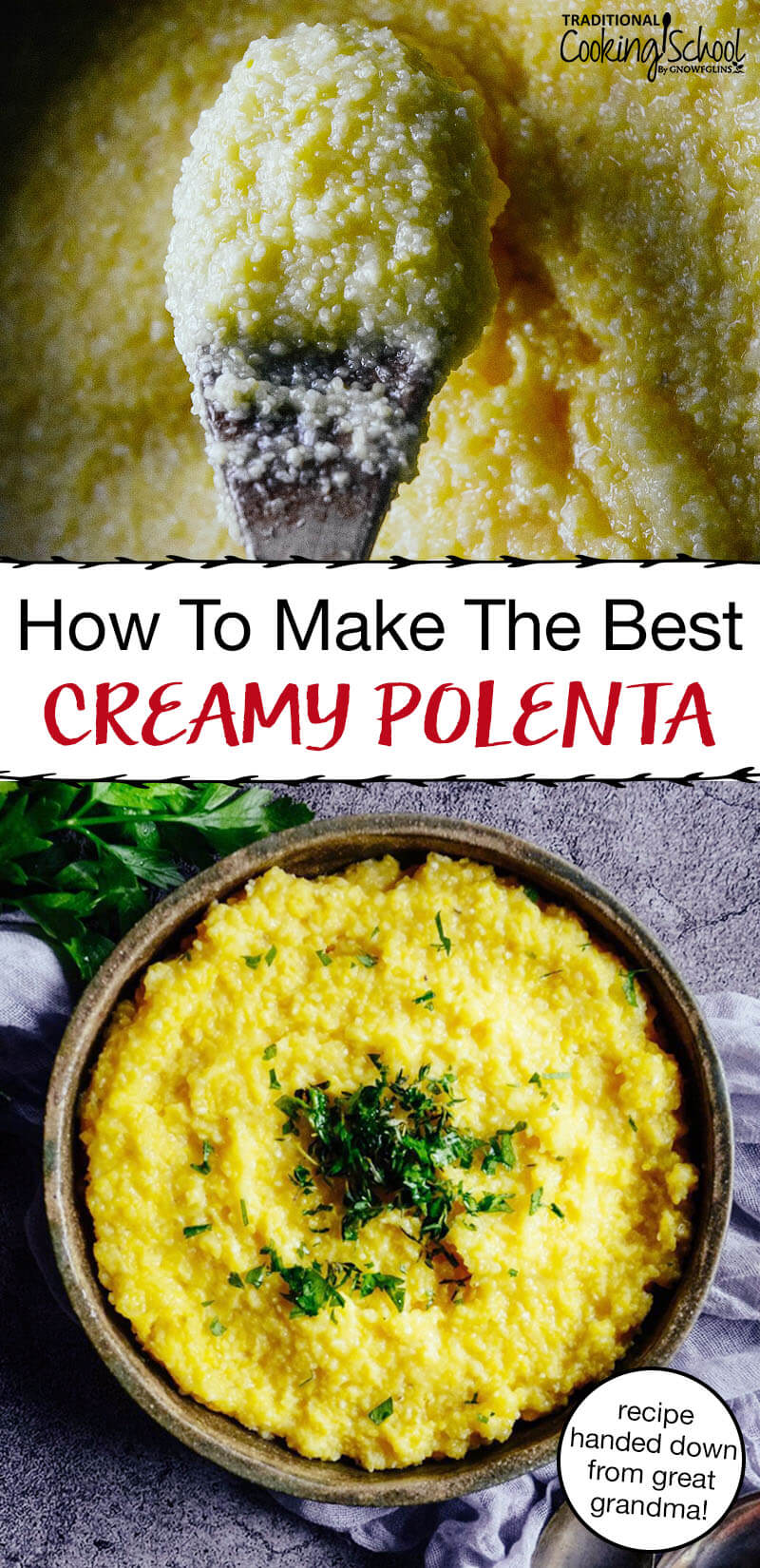
Looks really delicious!
Also very interesting how the polenta can be soaked. I’ve never done this before.
Thank you!
Thank you so much, Florian! I’m thrilled you think so! Yes!! It can be – and that’s good news for our all our guts! 🙂
Hi Daniela,
I grew up in Romania also! With lots of polenta in our diets too..we like it with sheep cheese ( cascaval!), sour cream and bacon in layers!
Also with milk! A long time ago when there was buffalo milk! Delicious!
Or plum jam! ( majun), a concentrated form made without any added sugar!
So wonderful to find your recipe! My family lives in Romania, and we enjoy having this on special occasions, though I’m sure the locals make it much better than we do! I’m curious if you have tried making it with masa harina, instead of soaking it ahead of time?
That is amazing!!! I’m so happy to meet fellow Romanian!! 🙂
I’ve never tried it with masa harina but I am absolutely googling that! I’m very curious! And I agree – the locals have it all figure out! ??
That is so amazing Daniela!!! It makes me so happy hearing that! Those sound like such fantastic options and truly take me back to the home country!! I also love that we share a name 🙂
Daniela,
I cherish your effort to teach us the proper traditional methods of cooking cornmeal. I am also a Romanian. Polenta has always been on our kitchen table, as a staple food. When you add the apple cider vinegar for the second soaking step(after the lime water soaking), will the sour flavor remain? Will polenta retain any of the sour taste from being soaked for up to 24 hours in an acidic media? Thank you for sharing this recipe with us.
Dear Carmen!
Thank you so much for your comment and so good to meet another Romanian! I’m sorry for the delay – your comment ended in my other mail! So with regards to the polenta…
It most likely will retain a slightly sour flavor- this is typical for soaking. With rice, you can rinse the soaking liquid away and replace with fresh to reduce the sour flavor. Since this isn’t an option for polenta, you’d have to skip the soaking step to get rid of the sour flavor completely. Sweet or savory toppings will mask the sour flavor, though, if it’s an issue. I personally enjoy the slight tang! So whichever option you choose, will work!
Hi Daniela,
thank you so much for this wonderful blog-article! I love polenta and i´m happy to make it creamier and more nutritive with your recipe. I have one question: I cooked it yesterday using the apple-vinegar. For my taste, it was to sour. Maybe another acidic medium as you wrote would have been better. But what exactly is the acidity for? Is it to neutralize the lime water? I´m just wondering because every recipe that i read about nixtamalizing whole corn doesn´t contain acidity.
Thank you so much & kind regards,
Maria
I would also like to know about the addition of acid. I have read many recipes for nixtamalized cornmeal, including Sally Fallon’s book. Many, but not all, warn about the lime, which is very alkaline. No one has explained how to eliminate the alkalinity and I have been afraid to use the lime water for fear of it damaging my stomach. So, as another commenter has asked, does the vinegar neutralize the lime rendering it safe to consume.
Do you just keep the polenta in the limewater/ vinegar and never wash it out? I thought limewater was irritating to skin – wouldn’t it be irritating to gut?
Why does no one clearly address this?